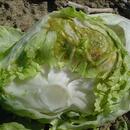All

Caused by the fungus Rhizoctonia solani, bottom rot is identified by sunken, reddish-brown spots on the bottom of plants, most notably, lettuces. If the fungus only affects the outer leaves they can be trimmed, but if it has invaded whole heads, they cannot be used. The spots most typically occur when leaves touch soil that contains the fungus and when temperatures are high and air is humid.
The Brix scale was named for a 19th century German named A.F.W. Brix. This system is used in the United States to measure the sugar content in fruit, most notably citrus, grapes, and melons.
What is it?
Umami is a Japanese word meaning delicious flavor; in English it is usually described as having a meaty or savory taste. It was first identified by Professor Kikunae Ikeda of Tokyo Imperial University in 1908 and is generally recognized as the fifth sense (along with sweet, sour, salty, and bitter).
Foods high in free-form glutamate (a naturally occurring result of the breakdown of protein molecules) have a distinct palatability, especially when combined with salt. It is thought that umami-flavored foods taste saltier or sweeter; it also balances bitterness or sour notes. Cooking, most notably roasting, intensifies umami flavors in foods that are naturally high in free-form glutamate.
Some examples are:
- Anchovies
- Beef
- Cabbage
- Carrots
- Cured meats
- Green tea
- Fish sauce
- Mushrooms
- Parmesan cheese
- Potatoes
- Tomatoes
- Sardines
- Seaweed (kombu)
- Shellfish
- Soy sauce
- Spinach
- Sweet potatoes
- Truffles
For more information about umami, see:
